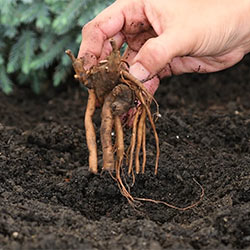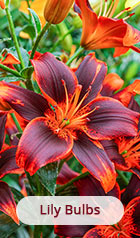The flowers are also treasured as cut flowers and are very showy in fresh floral displays. With some hydrangea varieties, the soil's acidity impacts the color of the blooms. Thanks to modern breeding efforts, hydrangeas are now available in a variety of colors and sizes. For many gardeners, hydrangeas are a must-have for the flowerbed or landscape. For tips on how to care for hydrangea trees and other shrubs, make sure to check out our trees and shrubs
planting guide. With their colorful varieties and beautiful blooms, hydrangea shrubs make the perfect addition to any garden. Check out our variety of hydrangeas for sale now!
How do you control hydrangea color?
Not all hydrangeas change colors, but many pink-to-blue varieties can be changed by controlling soil pH. In those cultivars, like
LA Dreamin' or
Twist n Shout hydrangeas, the level of soil acidity will affect the color of the flowers. These flowers become more blue in acidic soils, and lean to lilac or pink colors in less-acidic soils.
To make your hydrangea flowers more pink, you'll need to raise the soil pH (for those of us that don't remember chemistry, that means making the soil more alkaline and less acidic). Try adding wood ash or commercially-available lime to the soil, but be careful not to overapply. Follow the instructions on whatever products you decide to use.
Look for amendments that include aluminum, and check your local garden center or hardware store for specifically-formulated additives for hydrangeas.
What type of soil should hydrangeas be planted in?
Hydrangeas need well-draining, consistently moist soil. Soil for hydrangeas is a balancing act--it should be moist, but not wet, nutrient-rich but not heavy. The best way to achieve good quality bedding for hydrangea plants is to enrich the soil with loam or hummus. If possible, choose a planting site that has shade in the afternoon, or dappled shade throughout the day, to keep the soil from becoming dry and hot.
Hydrangeas can thrive in acidic or slightly alkaline soil, and some bigleaf or panicle hydrangeas actually change color when their soil pH is changed. The color-changing varieties typically grow in shades of pink to blue-white, green, and many pink hydrangeas do not change color. In those plants that do change bloom color, soil pH affects the amount of aluminum absorbed by the plant, which results in a shift from pink to blue. Hydrangeas planted in alkaline soil are more likely to remain pink or lavender, while hydrangeas planted in acidic soil and provided with aluminum may turn blue or lilac.
Should hydrangeas be deadheaded?
There's no need to deadhead hydrangeas, and deadheading won't necessarily encourage reblooming. Whether your hydrangeas bloom on "old wood," meaning that they should be pruned sparingly in fall, or "new wood," meaning that they can be pruned heavily in spring, you can leave the flower heads on your hydrangeas.
In addition to making care easier, not needing to deadhead in winter means that you'll get to enjoy the winter look of hydrangeas. Hydrangea flowers fade to a cream or brown color and dry out, but their shape holds beautifully and adds a lovely "snowball" effect through the winter.
When should I plant hydrangeas?
Hydrangeas are best planted in early spring, after all threat of frost has passed. Hydrangeas shipped as potted plants will likely bloom in the same year that the shrub is transplanted, while bare root plants may take a year to flower. An important thing to remember about hydrangeas-they don't like to be transplanted once established. Set your hydrangea in a good location, and then leave it alone!
How do you prune hydrangeas?
Pruning for hydrangea plants depends upon variety. There are two common times for hydrangea pruning-after blooming in the late summer, and after winter in the spring. We'll also note that hydrangeas do not need to be deadheaded, and don't truly require pruning. Pruning can help produce larger blooms, but most hydrangeas are happy to go without pruning.
Oakleaf, bigleaf, and climbing hydrangeas, should be pruned immediately after flowering. Make sure to prune these hydrangea varieties just after flowering, and well before autumn. Flower buds form in the late summer and flower the following season, so you don't want to prune any of those new buds. If you do find dead wood the following spring, you can prune away that material, but be careful. Feel free to leave the flowers on the branches that you don't prune.
Panicle and smooth hydrangeas don't develop flower buds until springtime, so you can leave the flowers on through the cold months. That's great news, as this style of hydrangea adds lots of winter texture to the garden! Prune these types of hydrangeas in late winter, when the plant is dormant and before new flower buds have formed. Pruning is easy on these plants, as you can remove old wood, take out crossed branches, and simply prune to shape the plant.
How much water do hydrangeas need?
Hydrangeas need more water than most other plants, especially in their first few years in the garden. In general, you can expect to water your hydrangeas deeply two to three times a week, providing at least an inch of water each time. Thirty minutes with the soaker hose can be a great way to irrigate your hydrangea plants. Remember that potted hydrangeas, or hydrangeas planted in hot climates or direct sun, will need more frequent watering.
A note on hydrangea hydration--hydrangeas prefer well-draining soil, and, even though they require regular watering, don't like to have "wet feet." Choose a location that won't allow your hydrangeas to become waterlogged, and amend the soil to give it a good, loamy texture.






















